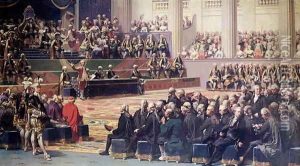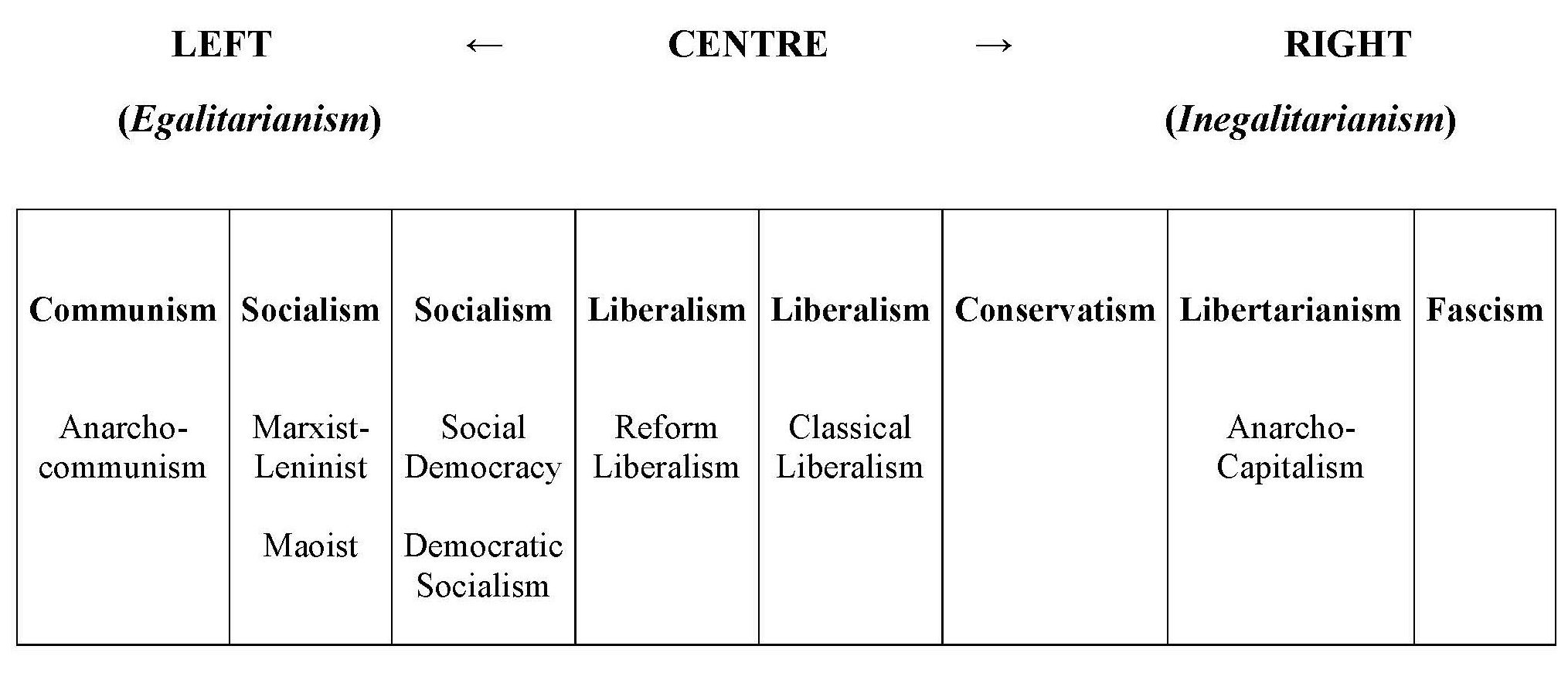1.3.1 Relating Ideologies: The Left-Right Spectrum
Gregory Millard
When people think about the similarities and differences between particular ideologies, they are often drawn to a spatial metaphor: the left-right “spectrum” or “continuum.” This left-right spectrum – an imaginary line, in effect – is an organizing device that helps us sort out how different ideologies relate to each other. A person is “on the left” of this line if their views reflect those of left-wing ideologies, and they are “on the right” if their views reflect those of right-wing ideologies. But what do these labels mean?

The classification of ideological argument into a left-right spectrum has its origins in the French Revolution. This developed from fairly moderate beginnings in 1789 into a violent, seething cauldron of ideas for rebuilding society from the ground up before culminating in dictatorship by the late 1790s. Some regard the French Revolution as ground zero for political ideology as we know it – the moment when the intoxicating idea that we could comprehensively refashion our social world branded itself irrevocably upon the modern imagination. And in terms of the ideological spectrum,
[m]ost scholars trace the origins of the words “left” and “right” to the seating arrangement of the Estates General in the years leading up to the French Revolution. … In the Estates General, radical democrats and their sympathizers sat to the left of the king, supporters of the clergy and the aristocracy on the right (Cochrane, 2015).
This gives us a hint as to what the left-right distinction is driving at. Indeed, there have been many answers to this question (e.g., Cochrane, 2015; Noël & Thérien, 2008; Bobbio, 1996; Laponce, 1981), but one convenient approach is to say that the two poles represent opposite views about human equality. Thinking about the ideological spectrum in this way can help capture much about how we actually use the terms “left” and “right.”
At the furthest point on the left of the spectrum, then, fall the most robustly egalitarian options available to modern political thought. To be “egalitarian” is to believe in the surpassing importance and desirability of equality in human relations. For the extreme egalitarian, human beings should have
- equal rights under law
- equal power and standing in the community
- and approximately equal possessions (insofar as they have possessions at all, as opposed to everything being owned in common).
A society that robustly realizes equality on all three of these dimensions may be described as communist or “anarcho-communist.” Don’t worry, we will unpack what these labels mean in greater depth in later chapters. All we need to know for now is that these far-left ideologies imagine a society in which there would be no state, no government, no coercive power (such as police forces), minimal (or no) private property, and no exploitation. We might, say, all live in small communes and share resources among ourselves. That is about as far left as one can go – because it is as ambitiously egalitarian as one can go.
At the further point on the right of the spectrum would come the most adamantly inegalitarian options available to political thought. These would entail a rejection of equal rights, equal power and standing, and equal possessions. For example, to believe in dictatorship is to say that one person, or some small group of people, are entitled to rights and privileges not available to others – in this case, the right and privilege to govern and make decisions for the whole society. Power in dictatorships is not shared, but completely and (in theory) permanently concentrated in a few hands. And the ideology of fascism (see figure 1.4) argued explicitly that the superior man – and it was always a male – must rule and wield absolute power. Fascists also argued that some groups of human beings should dominate others: stronger nations or races should subordinate the weaker. Finally, fascism rejected socialist ideas about wealth being equally distributed. Massive political inequality, and massive material inequality, were unapologetically baked into the ideology, even as its adherents spoke about a mystically unified nation. This extreme inegalitarianism means that it makes sense to position fascism as an ideology of the “far right.”

Between the two extremes of communism and fascism falls a group of more moderate ideological options. Democratic socialism, for example, slots “left” because it advocates for significant (not absolute) redistribution of wealth from rich to poor. This moves it closer to equal possessions, but not all the way there, even as it retains a belief in some degree of equal power and standing within the community via equal rights to political participation. Liberalism, for its part, is a very varied ideology, but by and large it is less emphatic about the redistribution of wealth and not quite so staunchly egalitarian as democratic socialism. It occupies the centre of our spectrum. Conservatism, meanwhile – at least as understood in the second half of the 20th century – tends to oppose the redistribution of wealth, favouring a higher level of economic inequality, while still (mostly) insisting on equal rights and equal rights of participation. It also tends to defend traditional social hierarchies, for instance, in the realm of gender relations and cultural identities. And so it falls to the right of liberalism. Libertarianism and anarcho-capitalism would unleash vastly higher levels of material inequality by reducing the state to a bare minimum or abolishing it altogether and organizing human affairs largely by market mechanisms. They can thus be placed further right still. Nevertheless, these configurations retain a commitment to equal legal rights. At the furthest point – fascism – this commitment drops entirely away, as we saw.
Media Attributions
- Opening of the Estates General at Versailles on 5th May 1789 © Louis Charles Auguste Couder is licensed under a Public Domain license
believing in the principle that all people deserve equality in human relations.
the rejection of equality in human relations.
form of government characterized by a single leader or a small group of people who hold power without constitutional limitations.

